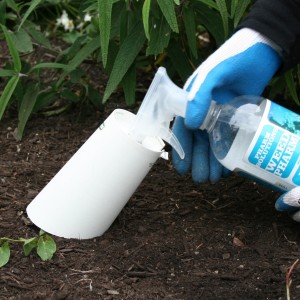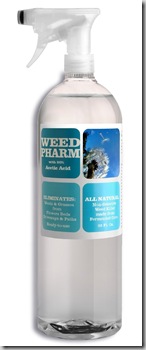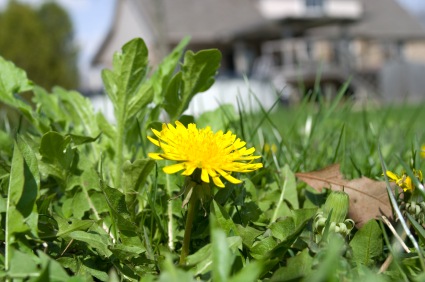 When I was in horticulture school, the old-skool dudes teaching pest control were all about the chemicals – they just didn’t believe organics could be as effective as the lethal stuff. Yet every so often, a hint of doubt would creep into their voices about safety.
When I was in horticulture school, the old-skool dudes teaching pest control were all about the chemicals – they just didn’t believe organics could be as effective as the lethal stuff. Yet every so often, a hint of doubt would creep into their voices about safety.
I’d hear, “well, this one’s actually pretty bad” or “ya don’t wanna get too close to this” and “this one’s chemically similar to Agent Orange and I’m not really sure why it’s still legal”.
What?!! “Agent Orange on your lawn” has never been the special Genevieve mojo I wanted to share with my gardening clients!
All right, geek talk ahead:
Weed N Feed and Weed B Gon contain 2, 4-D, which has some of the same toxic components as Agent Orange (read this Wikipedia article under the “manufacture” section for more info).
You may think of Roundup as being safer because studies have shown that it breaks down quickly in soil, and the company has claimed that Roundup is “practically non-toxic” to mammals, birds, and fish. However, recent evidence has shown that these old studies were deliberately falsified, resulting in 20 felony charges, fines, and jail time for those involved. Recent studies not involving jail time show that Roundup is an endocrine disruptor, which means it messes with our reproductive systems and hormones.
It also causes DNA damage and chromosomal aberrations. I don’t pretend to know what that translates into (cancer? thyroid issues? loud snoring?), but I know enough to not want that happening in my body.
(non-geeks, you’re safe to read again):
 So recently I found a type of organic weed control called Weed Pharm that is actually food-grade. Seriously! Lest you think, like my old hort. instructors, that food-grade means “doesn’t work”, I tried this stuff out in my own garden to see. You’re supposed to wait for outdoor temps to reach 60 degrees or hotter for it to work, but I didn’t – I just waited for a dry day and coated my weeds in it. Three days later the weeds were toast! Light brown, shriveled, and dead.
So recently I found a type of organic weed control called Weed Pharm that is actually food-grade. Seriously! Lest you think, like my old hort. instructors, that food-grade means “doesn’t work”, I tried this stuff out in my own garden to see. You’re supposed to wait for outdoor temps to reach 60 degrees or hotter for it to work, but I didn’t – I just waited for a dry day and coated my weeds in it. Three days later the weeds were toast! Light brown, shriveled, and dead.
It’s been two weeks and they have almost completely disintegrated. After two weeks I had one dandelion return out of all that I sprayed, which is really good – that’s comparable in effectiveness to Roundup. More established weeds will likely need a second or even a third spray, but mine were fairly new.
Like Roundup, it will kill any foliage it touches, so you can’t just spray it willy-nilly on your lawn. But you can kill dandelions in your lawn using Weed Pharm, via injection. (Learn what other techniques you can use to get rid of weeds organically in your lawn, in my eBook Guide to Organic Weed Control.
So, the good:
You can spray in vegetable gardens and places where you grow edibles, as well as garden beds around tree roots and in sidewalk cracks – just put a piece of cardboard between the spray “drift” and the foliage of any plants you would like to keep, and you’re safe. The residue’s gone in a day. It works fast. No chromosomal aberrations! Yay!
The bad:
It’s more expensive than the icky stuff and there’s no cheaper concentrated version available yet. It burns the tops of weeds off, so if you have ancient established weeds that have set up residence in an area, you’ll need to spray a second or even third time to kill them completely. If you keep up with your garden weeds somewhat often though, it seems to take care of them in the first try.
The odd:
 It’s made of vinegar. Like, super-concentrated not-your-mama’s-salad-dressing vinegar. So your garden will smell of salad dressing. The gloves you wear when spraying will smell of salad dressing. And every time you walk by your garden storage shed you’ll wonder why you have an inexplicable craving for greens. (it beats the hell out of smelling endocrine-disruptor fumes though, doesn’t it?)
It’s made of vinegar. Like, super-concentrated not-your-mama’s-salad-dressing vinegar. So your garden will smell of salad dressing. The gloves you wear when spraying will smell of salad dressing. And every time you walk by your garden storage shed you’ll wonder why you have an inexplicable craving for greens. (it beats the hell out of smelling endocrine-disruptor fumes though, doesn’t it?)
Ready to try it?
If you’d like to try Weed Pharm in your own garden, you can find sources for it on my Garden Tools page.
Want to learn more about organic weed control?
My eBook Guide to Organic Weed Control H
ow to Kill Dandelions in Lawn Organically using Weed Pharm
How to Kill Weeds Organically: Your Best Options W
ikipedia articles: Roundup, 2,4-D (Weed and Feed ingredient), Agent Orange [print_link]

16 responses to “Vinegar Weed Control that Actually Works”
I had no idea Monsanto falsified studies about Roundup. It’s something all eco orgs around here use to paint on stumps of invasives, like buckthorn. (Note, paint, not spray.) I’ll ask what they know about this!
Oddly, I don’t mind the smell of vinegar. In fact, I kinda like it.
.-= Monica the Garden Faerie´s last blog ..March Mish-Mash Monday =-.
I’m glad they’re painting and not spraying. I love to see evidence that people are really thinking about what they’re applying and how to minimize damage from it.
GENEVIEV,
It would be appropriate if you would understand some toxicology before making quotes about chemicals that you have no knowledge. You mention Agent Orange. Agent Orange is a combination of 2,4,5-T and 2,4-D and you generalize that it must be bad by association and not by Good Laboratory Studies (GLP); studies required by EPA. You should go back and re-read the information on 2,4-D and Agent Orange in Wikipedia. It states and I quote, “The controversies associated with the use of Agent Orange were associated with a contaminant (dioxin) in the 2,4,5-T component.”
Yes, there are controversies about 2,4-D but they all point to a non-issue of NHL with 2,4-D. Please take any reference to 2,4-D and Agent Orange out of this and any other article. I don’t have a problem with organics or use of a non-pesticide, but DON’T blame registered pesticides when you don’t have the facts.
Take glyphosate, your statement of falsified data. That is not true. If it were true then several individuals from Monsanto would be in jail! Also, EPA would have cancelled or at least restricted its use. Glyphosate is one of the safest compounds on the market.
As for your love of vinegar, you failed to inform your garden clients that vinegar is non-selective, meaning it may kill any vegetation sprayed. If you spray vinegar in the lawn for dandelions you will also damage or kill the grass.
L, you failed to give a working webpage with your comment, so I can’t tell beyond a doubt who you are and what company you work for. But it looks like you may have a vested interest in people having a positive opinion of these chemicals. I did a quick google search of the name you listed publicly along with the term 2,4-d and found a lot of writings by an L. Hammond on 24D.org.
Is this you?
Larry Hammond
Technical Chair, Industry Task Force II on 2,4-D Research Data
And this:
Mr. Larry Hammond, DowElanco Company and the Industry Task Force II on 2,4-D Research Data
If you work for Dow (maker of 2,4-D products), you’re hardly unbiased. You’d be out of a job if 2,4-D was banned!
I did not generalize that 2,4-d must be bad by association, I read the wiki article stating that components of it are often contaminated with dioxins (under “manufacture” on the 2,4-d page). The Agent Orange page said that dioxins were in large part what hurt people.
As for the issue with roundup, the wiki page states that someone did go to jail for falsifying these studies. If you read the link I provided thoroughly, they state that the glyphosate isn’t necessarily the problem so much as the other additives in roundup, which I can’t pick apart because roundup doesn’t tell us what is actually in there (it’s hardly “inert” if it makes the formulation more toxic, though, now is it!).
As for your allegation that if anything were harmful the EPA would have yanked it by now – I don’t think that’s true – look at all the pesticides that have been on the market and called safe, then were taken off the market because newer studies showed that there were NOT safe after all. The research seems to indicate that these herbicides are following the same path. Other countries are finding these herbicides unsafe and taking them off the market. I think your rush to insist they are definitely safe because the EPA says they are, ignores the history around this topic.
I don’t have a particular love of vinegar, so whatever you’re trying to accomplish with your sarcastic tone did not hit the mark. I love products that are effective and also the least toxic option possible. If you read my posts that I linked to, you’ll find I also have a “love of” weed torches, hoes, hand-weeding, injecting weeds, mulch, boiling water, pelargonic and citric acid herbicides, and other less-toxic options. It IS non-selective, which is why I give instructions for injecting dandelions in your lawn.
Seriously, L, you have a lot of animosity here – but which would you rather drink – Weed Pharm or Roundup? One’s been shown to be lethal in a few hours and the other’s food-grade.
Having learn how horrible toxic Roundup and other Monsanto, Dow, etc products are I happened by your site looking for alternatives. I know this has been awhile but I wanted to comment anyhow. I think most of us (myself until recently included) think the EPA, USDA, FDA are the good guys out to protect us. But nothing is further from the truth. I just want to point out that our government has a long standing relationship with big corporations – and one like Monsanto in particular. The Obama administration alone has the bad habit of appointing Monsanto CEOs for instance in advisory and regulatory positions within our government. To me that is ALWAYS a conflict of interest, but when they show up in areas as mentioned above, clearly they are not placed to protect us from the toxins in those chemicals. Follow the money. Monsanto is rotten to the core and is deep into bed with our government. Follow the money. Just google the appropriate key words and you will find that the dots all connect very easily.
L. Hammond,
Sorry, did I miss the part where Roundup IS selective? I mean to plants other than those grown from seeds genetically modified by Monsanto to be resistant to Roundup?
So what exactly is your beef with vinegar then since in that manner it behaves the same way that Roundup does?
.-= Erin´s last blog ..Get in the mood for gardening =-.
Genevieve,
Since you don’t understand toxicology your comments are very much in question. Referring to wiki is like referring to an opinion and is not considered accurate science. 2,4-D has been tested for dioxin for the many years and no 2,3,7,8-TCDD has been found at or above the level at the LOQ of 0.1 ppb. These test have been completed by several manufactures and data accepted by EPA, Canada PMRA, Europe, New Zealand and several other country regulatory agencies. The concern for dioxin in Agent Orange was with the 2,4,5-T and not 2,4-D. Over the past 20 years there have been over 300 new 2,4-D studies completed and reviewed by EPA and PMRA. Both countries have reregistered the molecule and in-fact reduced restrictions because new GLP studies show lower toxicity than the old 1970s or 1980s studies.
Again I make my point: When used as directed by the label 2,4-D can be used safely.
Well, Larry, I appreciate you taking the time to make your point.
However, I don’t think referring to wiki is like referring to opinion because at least in this case, the sources and references that back up the info in the wiki article are pretty thorough.
You are right that I’m certainly not a toxicologist. Thanks for making your rebuttal clearly and with scientific language, I appreciate that. I’m glad to hear that many studies have shown that dioxin may not be the problem indicated by the wiki article.
But I have a question for you. If you were storing a product in your shed and your child were to drink it in an unsupervised moment, which product is less likely to kill them? Food-grade vinegar Weed Pharm, or Weed B Gon with 2,4-D? Weed Pharm or Roundup?
And a follow-up: thinking of the folks who work in manufacturing these products, which would you say is more dangerous for the workers – food-grade Weed Pharm or 2,4-D? Think carefully on this one. I don’t think anyone’s in danger of dying in a couple hours if they are exposed to a food-grade vinegar product like this worker did when exposed to 2,4-D:
http://lists.essential.org/1998/dioxin-l/msg00929.html
The fact is, you’re paid by a company that manufactures this product to prove that it is safe, and the best conclusion you can come to for them is that it “can be used safely”. Not that it’s perfectly safe, not that you can spill it on yourself and not have to do a big scary scrubdown, and not that you could sprinkle it on your salad without getting sick – but that it can be used safely.
It seems like the reasons people would use this product in their home garden would be low cost and convenience. Looking at the possible risks that HAVE been found with 2,4-D exposure, the question becomes – why take the chance?
From wiki:
The amine salt formulations can cause irreversible eye damage (blindness); ester formulations are considered non-irritating to the eyes.
One study found that occupational exposure to 2,4-D caused male reproductive problems, including dead and malformed sperm.[4]
[edit] Cancer risk
Different organizations have taken different stances on 2,4-D’s cancer risk. On August 8, 2007, the United States Environmental Protection Agency issued a ruling which stated existing data does not support a conclusion that links human cancer to 2,4-D exposure.[5] However, the International Agency for Research on Cancer (IARC) has classified 2,4-D among the phenoxy acid herbicides MCPA and 2,4,5-T as a class 2B carcinogen – possibly carcinogenic to humans. [6] A 1995 panel of 13 scientists reviewing studies on the carcinogenicity of 2,4-D had divided opinions, but the predominant opinion was that it is possible that 2,4-D causes cancer in humans.[7]
A 1990 study of farmers in Nebraska, even when adjusting for exposure to other chemicals, found that 2,4-D exposure substantially increased the risk of Non-Hodgkin’s lymphoma (NHL).[8] A 2000 study of 1517 former employees of Dow Chemical Company who had been exposed to the chemical in manufacturing or formulating 2,4-D found no significant increase in risk of mortality due to NHL following 2,4-D exposure, but did find an increase in risk of mortality due to amyotrophic lateral sclerosis. [9]
2,4-D is manufactured from chloroacetic acid and 2,4-dichlorophenol, which is itself produced by chlorination of phenol. The production process creates several contaminants including isomers, monochlorophenol, and other polychlorophenols and their acids.
The powerful defoliant and herbicide Agent Orange, used extensively throughout the Vietnam War, contained 2,4-D. The controversies associated with the use of Agent Orange were associated with a contaminant (dioxin) in the 2,4,5-T component. However, 2,4-D is still contaminated to some extent with dioxins, predominately those with 2 or 3 chlorine atoms. Another form of dioxin, 2,7-dichlorodibenzo-p-dioxin (DCDD), an inevitable by-product of 2,4-D manufacturing, was found to be “equipotent” to dioxin TCDD in its toxic effect on the immunity of mice. TCDD received all the publicity while the DCDD component was largely forgotten.[10][not in citation given] To this day DCDD is not regulated or monitored by the EPA and PMRA, even though DCDD levels could be at much higher levels than TCDD.[citation needed] The typical smell of 2,4-D is the break-down product 2,4-dichlorophenol which is a suspected endocrine disrupter and possible carcinogen. 2,4-D is toxic to the liver at small dosages. Increases in liver function tests, jaundice, acute hepatitis, lobular and portal inflammation indicative of a toxic reaction, as well as permanent damage leading to cirrhosis has been reported in exposed golfers [11][12][13]
Genevieve,
I don’t really have a problem if you want to promote organics or if you want to promote Weed Pharm…that is your agenda. The problem that the 2,4-D industry has with articles like yours is the mis-represtation of pesticides, using old disproven studies and studies with poor protocols to make a point. To blame the 2,4-D or other herbicides based on tox to promote your product or position is rather disingenuous way of trying to sell or promote a product.
To be honest with you, there are so many incorrect statements and references in your response, it is not worthy of a response. It really looks like you copied the information from another activist’s paper or article. For example, there are several reference numbers but no references listed. The best thing for you to do is review the 2,4-D web page: , and visit some of the “Backgrounders” which explain many of the points that you have mis-characterized.
I guess we can agree to disagree but please let sound science guide your opinions and not some junk science web site.
By the way I’m an independent regulatory affairs consultant.
Um, yes, you clearly aren’t reading my response very well – I did say “From wiki:”, and I’ve linked multiple times to their web page which DOES have the references listed. The references do not look like junk to me. They just look like they disagree with you.
You may be “independent” in some fashion, but you’re also clearly linked to Dow in many of your papers. A simple google search turns that up.
You didn’t answer my questions in my last response to you, by the way. I suppose the answers are pretty obvious.
L. Hammond,
You may be an “independent” regulatory consultant (although it’s obvious that the independent part is a matter of opinion), but I’m wondering: Are you a gardener?
.-= Erin´s last blog ..Free your garden (and yourself) from the grip of Roundup =-.
Genevieve,
You have been focusing on pesticides and in particular 2,4-D, but tell me where I can find research on vinegar to show long term carcinogenic studies? Are there at least three mutagenicity studies completed? where are the metabolism studies, the developmental (teratology) studies, the neurotoxicity studies on vinegar? Doses Weed Pharm even have a set of acute tox studies? Where are the environmental fate and ecotoxicity studies? To Erin: my beef with vinegar is that if vinegar was tested at the same level as pesticides for EPA and other country regulatory agencies, then we would have a level playing field to make toxicological and environmental comparisons.
I didn’t answer your question on drinking because that is a hypothetical question.
You made another point that was a mis-representation of the information of a manufacturing accident, “… danger of dying in a couple hours if they are exposed to a food-grade vinegar product like this worker did when exposed to 2,4-D.” If you had read the information from the URL carefully you would have noticed that it was NOT 2,4-D but 2,4-dichlorophenol (2,4-DCP). This was an accident, the worker was not wearing protective equipment as required and the 2,4-DCP was hot, ~140 degrees C when the hose or pipe broke, thus he was exposed to severe third degree burns and the raw chemical. It is your mis-information like this that is very disturbing.
Please send me your email so that I can send you definitive info on herbicides.
This is my last communication on this subject.
Finally, Larry, something we can agree on! I’d love vinegar to go through that same rigorous testing. More information would be a very good thing. But common sense would guide me to believe that a product that is food-grade would be less toxic than products that are not food grade.
My question about whether you’d rather have your toddler accidentally drink one product over the other is hypothetical, but still proves a point. It’s obvious which product any parent would rather have their toddler get into by accident – there’s just no contest.
You are correct that I accidentally mis-represented the info about the manufacturing accident, and I apologize for that. But I AM curious as to what you make of the link between Dow employees exposed to 2,4-D and amyotrophic lateral sclerosis.
Quoted again, from wikipedia, references on wikipedia:
“A 2000 study of 1517 former employees of Dow Chemical Company who had been exposed to the chemical in manufacturing or formulating 2,4-D found no significant increase in risk of mortality due to NHL following 2,4-D exposure, but did find an increase in risk of mortality due to amyotrophic lateral sclerosis.”
My email’s on my contact page, and you’re welcome to send me any information you think would be edifying.
I was reading along and clapping my hands over an organic spray for the weeds in my gravel driveway–and next thing I knew Gen and L. Hammond were in The Fight of the Century. Who says garden blogs are lightweight? This was most interesting.
Still worried about the loud snoring though.
.-= Daffodil Planter´s last blog ..Daffodil Blogorama 2010 =-.
I know, Daff! The image of gardeners is very peaceful and quiet, yet there always seems to be something exciting going on in the gardening world, or something new and thrilling to learn and debate.
Larry Hammond’s been kind enough to send me some scientific papers via email that I’ve been interested to read, and I really appreciated the chance to learn more here. I’m still standing by my comments, but I’ve been very happy to hear his side argued.
LHammond, You and your pointless arguments need to move on. Nothing you or anyone else says will ever induce me and many others to touch these chemicals or frankly anything else similar. We don’t trust the corps or regulatory agencies and that is permanent.
Get out of town.